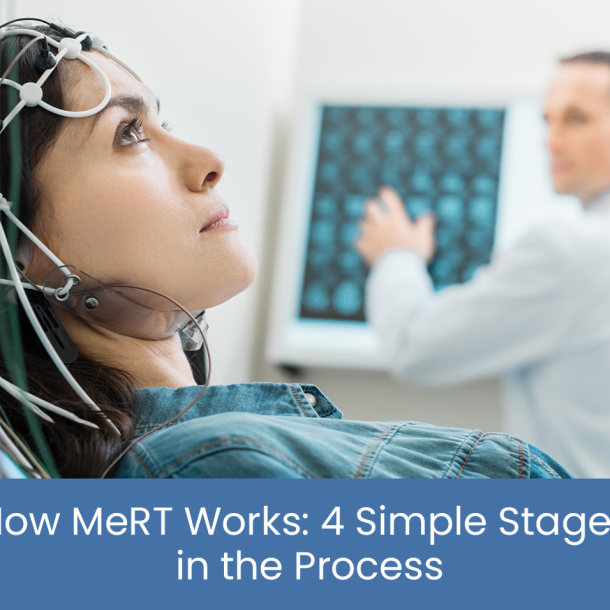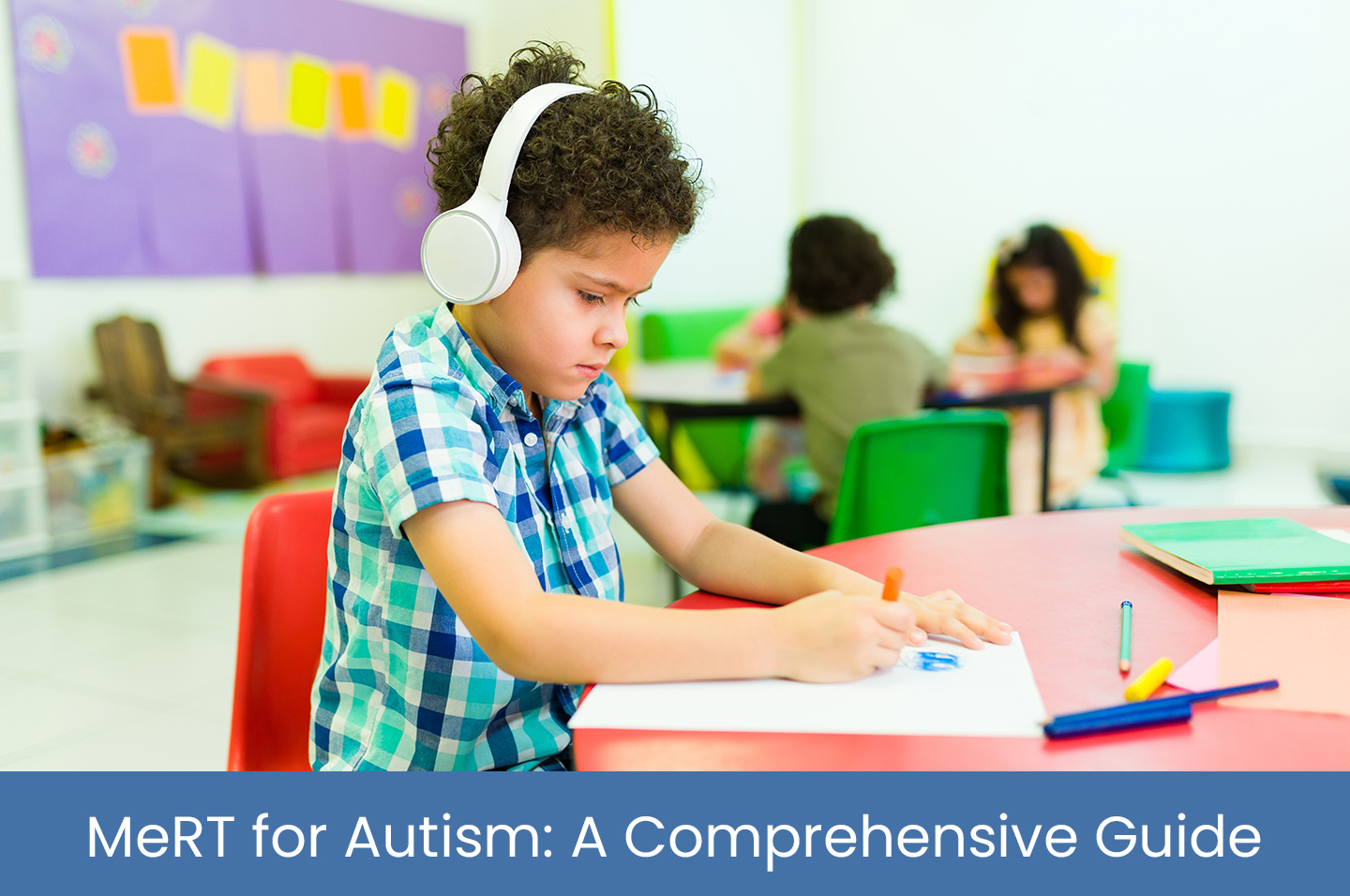
MeRT for Autism: A Comprehensive Guide
- Home /
- MeRT for Autism: A Comprehensive Guide

Magnetic Resonance Therapy (MeRT) involves the usage of customized Transcranial Magnetic Stimulation (TMS). Experts base treatment plans on a series of diagnostics. MeRT treatment for autism is painless, non-invasive, and drug-free. Regarding treatment for autism, MeRT boasts a significant improvement rate in alleviating symptoms.
What is MeRT?
MeRT utilizes repetitive Transcranial Magnetic Stimulation (rTMS) to improve brain function. The treatment is a four-step process involving conducting diagnostics using a qEEG (quantitative electroencephalogram) and EKG (electrocardiogram) to view brain function. A thorough analysis by a scientific team allows experts to establish a customized plan for our clients.
A qEEG provides experts with a map to guide them through a customized treatment plan. By identifying areas in the brain where dysfunction occurs, they can identify various brain disorders.
The treatment equipment is FDA-cleared and creates magnetic waves to gently stimulate targeted brain areas. This assists in improving brain function and connectivity. The treatments have become well-known for their ability to improve eye contact, connection, developmental delays, and speech for those diagnosed with autism.
However, clients should note that each person’s brain responds differently to treatment. Therapy starts with identifying where the brain isn’t communicating properly. Once located, we nurture treatments to strengthen functionality.
Understanding Autism
Individuals with autism spectrum disorder (ASD) can display any of the following signs at various ages. These include:
At 12 months:
- No or minimal babbling speech
- Little/no eye contact
- Shows increased object interest instead of people
- Appears to not hear when they are directly spoken to
- Play is limited or unusual
- Repetitive finger, arm, hands, or head movements
At two, signs may include:
- Specific areas of interest
- No or limited interest in other kids
- Behavioural challenges (self-isolation or self-injury)
- Repeats phrases or works without understanding the meaning
- Challenges with reciprocal social interaction
- Likes to have things done in a specific manner (like only eating certain foods)
At any age:
- Minimal eye contact
- Reactions to taste, light, sounds, smells, textures, and colours
- Specific interests
- Repeats certain behaviours
- Repeats specific words/sentences
- Delays in developing language and nonverbal communication
- Intense reaction to routine or environmental changes
How does MeRT therapy mitigate autism?
While the full benefits of MeRT treatment for autism are still being explored, there are many theories that explain its advantages.
Prevailing Theories
One theory states MeRT regulates the autonomic nervous system (ANS). It improves movement patterns and sensory experiences. These improvements regulate the ANS to promote better self-regulation, emotional health, and attention skills.
Another suggests MeRT enhances neuroplasticity and neural connectivity. When specific locations in the brain receive stimulation with sensory input/targeted exercises, there is an improvement in how existing neurons function and there is a development of new pathways.
MeRT can influence hormones and neurotransmitters, which regulate behaviour and mood. The sensory input that MeRT provides can increase serotonin, endorphin, and oxytocin levels. These neurotransmitters are responsible for generating feelings of happiness, relaxation, and social connectivity.
MeRT works by placing a powerfully small electromagnet on your scalp. Pulsing magnetic waves go to the brain, which then activate or deactivate neurons. The activation/deactivation of neurons depends on the findings.
Assessing and addressing how neural networks communicate in the brain provides experts insight into how autistic individuals experience their surroundings. This allows them to reach their full potential despite symptom severity.
How MeRT Alleviates Autism Symptoms
Developmental Delays
Those experiencing developmental delays have indicators appearing in the ¾ of the front of their brain responsible for emotional processing and social cognition. In autism, a mixture of slow Theta and Delta waves dominate brain waves in the front of the brain, and they exhibit high Beta waves. Experts compare these findings to someone who does not have autism.
Recording an EEG and utilizing obtained data assists us in creating personalized treatments. Experts apply treatments to the front of the patient’s brain to decrease disorganization and boost brain understanding.
Those experiencing this treatment report better sleep, enhanced quality of life, and improvements in social behaviour.
Boosts Independence
Since therapy increases the development of life skills, autistic individuals increase their problem-solving capabilities and self-care, and are generally better organized.
Decrease in Challenging Behaviours
MeRT can reduce instances of aggression and meltdowns. Strategies are incorporated to manage and decrease behavioural outbursts.
Improved Emotional Regulation
Autistic children may not be able to regulate their emotions. MeRT enables kids to understand their emotions, leading to better emotional well-being and self-control.
Better Social Skills
Autistic children have challenges with social interactions. MeRT improves interaction and communication for children. It generates better eye contact, fostering improvements in social connectivity.
Special Considerations
MeRT can provide hope for families with autistic children. However, results from this therapy vary because each child’s brain responds differently to treatment. For this reason, we closely and regularly monitor a patient’s progress to determine its effectiveness.
Some kids may receive marked improvements in symptoms. With others, there may be a slower change.
Additionally, MeRT isn’t suitable for all autistic kids, and varying factors determine eligibility. Before undergoing therapy, we advise you to meet with a healthcare professional to see if treatment is advisable for your child.
Professional evaluations include examining the following factors:
- Symptom severity: Autistic symptoms vary on a spectrum. The nature and severity can influence the effectiveness of therapy.
- Age: Some ages/developmental stages respond more positively to MeRT therapy.
- Needs: Customized interventions address autistic challenges. MeRT is best suited to those needing these modalities.
What is the average result?
Children generally show improvements in symptoms with long-lasting results. While some experience lifetime results, they schedule additional treatments to track progress and for follow-ups.
Families with autistic children may feel frustrated by a lack of available treatments. However, by booking an appointment for MeRT treatment for autism with Neurosync Brain Treatment Centre, you can help your child experience improved brain function to enhance their quality of life.
To book your appointment or if you have questions and concerns, call 365-799-8438 or fill out our online form and contact us here. One of our trained experts will contact you shortly with an appointment time.
Working Hours
Email: neurosyncbtc@outlook.com
Woodbridge. ON. L4L 1A6

